Matador Network's Blog, page 2299
March 17, 2014
Happy St. Patrick’s Day from Dublin!
EDITOR’S NOTE: Last year, Matador’s Scott Sporleder and Candice Walsh traveled to Ireland where, in addition to meeting the President and taking part in a St. Paddy’s Day parade through downtown Dublin, they road tripped the country and came back with the following stories:
What St. Patrick’s Day looks like in Dublin
I went to Ireland to find my roots and discovered I’m Canadian
The ultimate Ireland road trip, in pictures
Happy St. Patrick’s Day!
The post Happy St. Patrick’s Day from Dublin! appeared first on Matador Network.

5 ESL challenges in China

Photo: Peter Morgan
I SEE A NEW FACE at the expat bar every weekend, undoubtably drawn to this frozen corner of Heilongjiang Province by the promise of a lifestyle change, adventure, and a unique cultural experience — along with a free apartment, money, and a 15-hour workweek.
I don’t want to be the one to burst their bubble while they’re holding their drink, still high off jetlag and excitement, but these are five of the headaches that await them on their TEFL journey.
1. Workplace inequality
China is indeed a communist country, but you’d better believe your private language center is a purely capitalist venture. And you — the unmistakable, foreign-looking face — are their flagship product. You will be pampered with an amazingly modern apartment, a hefty salary, and light hours. It’s pretty awesome, if I’m honest.
This begs the question, though: Can you deal with the fact that your Chinese counterpart is making pennies for working twice as many hours as you? Can you stomach the wine you’re drinking over Christmas dinner, knowing your assistant is stuck at work, covering your half of the lesson? Many schools have the attitude that their Chinese employees are disposable. You’ll have more luck shooting baijiu without cringing than fighting the glaring inequality at your school.
2. Terrible textbooks
Part of running a business is making costs as low as possible in an effort to maximize profit. Your school is no different, which means some of your textbooks will be riddled with horrific errors and probably will have not even been written by a native speaker.
Not only must you convince your Chinese assistant that “May I play your ball?” is, in fact, not correct, but you will also constantly struggle with the uselessness of some sentences you’re required to teach. These can range from the creepy “You want it, you say it, you get it,” to the whoever-wrote-this-textbook-was-high level of ridiculousness: “He must be in the lemon house.” Just bring ibuprofen and you’ll be okay.
3. The parents
One of the most irritating things that plague the majority of language centers is the ridiculous amount of influence parents have. For one, you can’t fail the kids. We actually have to give the children an 8/10 or higher on the oral exams, even if they clearly don’t belong in that class. Their child is flawless; so the reason they’re not doing well must be the school’s fault. The solution? Give an arbitrary score that makes it impossible to fail. The parents are happy being lied to, and the school doesn’t lose any money. The only downside is feeling like your last three months of teaching were pointless.
You’ll also receive some questionable criticism from parents who shouldn’t even be given the time of day, but the school is on their hands and knees in front of them so you’ll hear it anyway. My favorite is when a mother told me I was teaching the book incorrectly. Her English consisted of “hello” and “thank you.” I’ve recently changed my strategy from protesting and reminding my boss that the parents don’t speak English to just nodding, saying “okay,” and continuing to do things my way.
4. Little emperors
China’s one-child policy has created a phenomenon so prevalent that it now has capital letters and its own Wikipedia article: Little Emperor Syndrome. Children of urban families, who now have exponentially more purchasing power than even just a few years ago, are showered with affection and material goods from parents, grandparents, and pretty much everyone around them. Parents will even take their jackets off for them and hand them their water during break time, from kindergarten to my oldest class of 13-year-olds. They get used to it.
While I’ve found children in China to be far more respectful to teachers than their American counterparts, you will definitely still have a few that expect their every whim to be fulfilled. They’ll demand to play a game when you’re in the middle of explaining the past perfect tense, and they’ll demand a different game if that game is boring. Some seem a bit shocked when they finally discover they’re not going to be getting the same amount of attention their parents give them. Treat every child equally early on, set strict rules in class, and hopefully you won’t have too many tantrums.
5. Chinese office culture
The primary source of frustration will almost certainly come from the management of your school, and the office politics that ripple out from their decisions. Something future teachers must understand is that business runs on a different clock in China. Rid yourself of the Western idea of having your calendar a month in advance, or even being given 24-hour notice (even if it’s in your contract) for some activity your school has pulled out of thin air for you to do. Throw “organization” out the window.
Not too long ago, our headmaster had the bright idea to allow renovations in the middle of the autumn term, making several parents furious, some even withdrawing their children from the school. Our boss told us we would be moving into a public school for two weeks (technically illegal, but the headmaster has connections). One of the other foreign teachers laughed and said, “Oh, so you mean two months?” Sure enough, we were there with chalkboards and no teaching materials for a bit longer than 60 days.
You really just have to take a deep breath, roll with the punches, and accept that this is how things work here, or it’ll be very difficult for you to thrive in this country. 
The post 5 challenges you’ll face as an English teacher in China appeared first on Matador Network.

How to piss off someone from Pittsburgh

Photo: Melissa Dooley
Every now and then, some advertising campaign thinks it’s funny to use Pittsburgh as the butt of a joke: a travel agency who pretends that’s the worst place on earth you could end up, with the kind of nose-wrinkling condescension that says, “Nobody would EVER voluntarily go there.”
For anyone who’s actually lived and loved in da ‘burgh, though…we know the truth.
Assume everybody loves the Steelers.
There are 99 reasons to move to the Steel City, and the Steelers ain’t necessarily one. Pittsburgh has a booming artistic community, several top-notch universities, and a tech industry to rival the Bay Area. Sure, there’s black and gold memorabilia in most shop windows, and you can buy a Terrible Towel in the airport…but assume every Pittsburgher is a sports fan and you deny the rich cultural landscape that makes up the rest of the city.
Assume nobody loves the Steelers.
I mean, come on. It’s the STEELERS.
Laugh at our yinzer accents.
Most places have a regional dialect or accent, no matter what language they speak. Pittsburgh is no exception. Native Pittsburghers and people who have lived here for a long time can have a very particular accent, often scattered with extremely specific slang.

More like this: 7 signs you were born and raised in Pittsburgh
This is most commonly characterized by using “yinz” for the second person plural — like “y’all” down in Georgia — and can include the use of words like “redd up” (short for “ready up,” meaning to tidy) and “gumband” (rubber band). The yinzer accent reflects blue-collar steel worker roots, and it can be a source of fierce pride. Mocking it is for jerks.
Ignore the view of downtown when you’re coming through the Fort Pitt Tunnel.
I never fail to get excited by the skyline when I drive in from the airport, with the impressively castle-y PPG building and all the floating restaurant business down by Station Square. I will make anyone in the car with me shut up and pay proper attention to this impressive sight. If you are not impressed, you can get out of the car. Yes, on the bridge.
Say “the bridge” without specifying which one.
Dude, the city has three rivers and something like 450 bridges. You can’t give me directions to somewhere by telling me to go over a bridge unless you tell me exactly which one. The Hot Metal Bridge is in a very different place from the Liberty Bridge. Also, you know that half of the smaller streets in the back neighbourhoods still don’t have street signs, right? Give very good directions, please.
Make fun of our dinosaurs.
Andrew Carnegie funded some crazy useful archaeological research. That’s why we have dinosaur skeletons everywhere. If you had a life-size T-Rex outside your art museum or inside your airport, you’d be proud of it too. We also have more library branches than almost any other city of comparable size, thanks to Andrew Carnegie’s lust for learning.
Call Pittsburgh part of the Midwest.
Look, son, Ohio is part of the Midwest. They have the flat nasal accents and the somewhat red-state values to prove it. Pittsburgh is part of the Northeastern states and is a lot closer to New York than Nebraska in behavioural patterns, the artistic community, and tech influences. Pittsburghers also really hate it when you say Cleveland and Pittsburgh are basically the same city. I mean, HATE.
Ask why we need to put coleslaw and french fries on a sandwich.
I think the real question is, why doesn’t everybody? If you could do what Primanti Brothers does, and have your entire meal in one conveniently portable bundle, you’d already be doing it right now. Besides, that study that said eating too much salt is bad for you turned out to be based on faulty research. Now pass the “O” fries. [image error]
The post How to piss off someone from Pittsburgh appeared first on Matador Network.

29 powerful images of protest
WITH ALL THE UPHEAVAL and rebellion going on in the world today, we see a lot of photos when something crazy happens.
Sometimes, the images are so powerful and mesmerizing that they stick with you afterward and make you understand what’s happening in that conflict on a much deeper level.
In this gallery, we’ve collated photos from protests and demonstrations worldwide that you won’t forget anytime soon. 

1
Athens, Greece
The fascist political party Golden Dawn started to rise to power in Greece, and last year anti-fascist and anarchist protests sprang up across the country in response, particularly in Athens. Molotov cocktails and police brutality were common fare.
(via)

2
Euromaidan, Ukraine
Violent demonstrations erupted in Kiev, Ukraine, in November 2013 as protesters called for the resignation of the president. In this photo, priests form a wall between protesters and police.
(via)

3
KKK, Georgia, USA
This photo of a small child touching his reflection in a policeman's shield during a Ku Klux Klan demonstration in Georgia in 1992 became famous. The child's first name is Josh, but nobody knows what happened to him.
(via)
Intermission
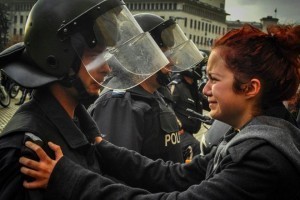
11 images to remind us of the need for activism around the world
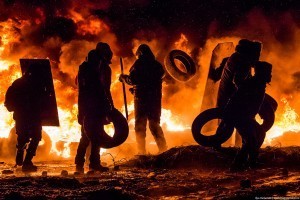
30 apocalyptic images from the protests in Kiev, Ukraine
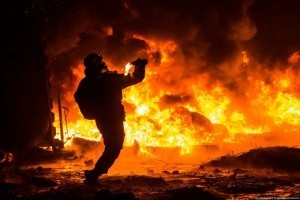
30 shocking images from the Ukraine protests show how protestors are battling the police

4
Occupy Seattle, USA
During the Occupy protests in 2011, 84-year-old protester Dorli Rainey was pepper-sprayed in the face by police. This photo shows other protesters helping her to safety. A pregnant 19-year-old was also sprayed on the same night.
(via)

5
Athens, Greece
An anti-fascist protester is attacked by a policeman amid clouds of teargas during an anarchist protest in Athens.
(via)
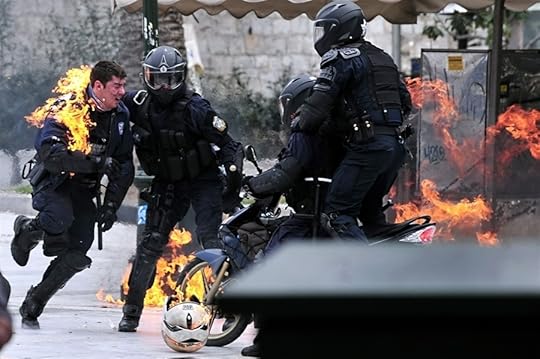
6
Athens, Greece
The protesters fight back by shooting Molotov cocktails at police and members of Golden Dawn.
(via)

7
Elsipogtog First Nation, New Brunswick
First Nations protesters blocking a fracking company's access to native land in northeast Canada were met by excessive force on the part of the RCMP...but they eventually won, and the fracking company was turned away permanently.
(Photo: Ossie Michelin)

8
Occupy Gezi, Istanbul, Turkey
In May 2013, anti-development protesters occupied Gezi Park in Istanbul, Turkey. This protester quickly became famous for playing accordion to keep morale of the occupiers up.
(via)

9
Occupy Gezi, Istanbul, Turkey
This Sufi dancer wearing a gas mask was one of the most powerful images to come out of Gezi Park; he danced in different colored robes on different days, but always wore a mask. His identity is unknown.
(via)
Intermission
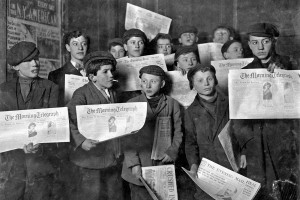
33 iconic photos of people standing up to injustice

Protesting Feliciano: Images from a human rights march in Brazil
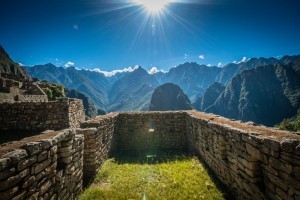
40 images of Peru we can’t stop looking at

10
Occupy Gezi, Istanbul, Turkey
The Woman in the Red Dress became a symbolic photo for the Gezi protesters: the beauty of the dress contrasted strongly with the brutality of the police firing pepper spray directly into her face.
(via)

11
Occupy Oakland, USA
As part of the larger Occupy Wall Street movement, Occupy Oakland created "Move In Day." Participants aimed to inhabit and renovate a long-abandoned building, making it into a community center. The police were not amused.
(via)

12
Occupy Oakland, USA
Protesters used homemade shields to stand their ground against police lobbing tear gas and smoke bombs.
(via)

13
Pepper spray cop, USA
During Occupy protests in 2011, students at UC Davis staged a demonstration on campus and Lt. John Pike became notorious for blithely walking along a row of protesters, pepper-spraying them in the face.
(via)

14
Vancouver riots, Canada
After the Canucks lost to the Boston Bruins at the 2011 Stanley Cup, Vancouver hockey fans took to the streets to riot...and this couple was left in the aftermath.
(via)

15
Tahrir Square, Egypt
The square has become the de facto site for protests in Cairo. The Egyptian Revolution of 2011 started there, when millions of protesters took to the streets demanding the resignation of the president.
(Photo: Reddit user latenightcabdriving)
Intermission
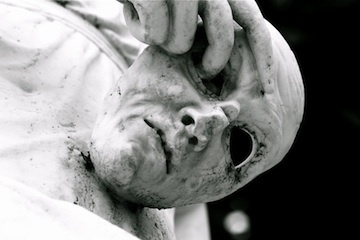
21 weird statues from around the world
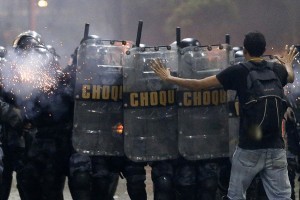
How to report on protests: Getting involved vs. staying impartial

50 images of New Zealand we can’t stop looking at

16
Crying cop, Philippines
A riot cop sent to block protesters in the Philippines began to cry and was comforted by protesters as the demonstration grew more violent on both sides.
(via)

17
Battle in Seattle, USA
The 1999 World Trade Organization negotiations were interrupted by enormous protests; police and protesters clashed extensively, and crowds were eventually dispersed with stun batons, tear gas, and rubber bullets.
(via)
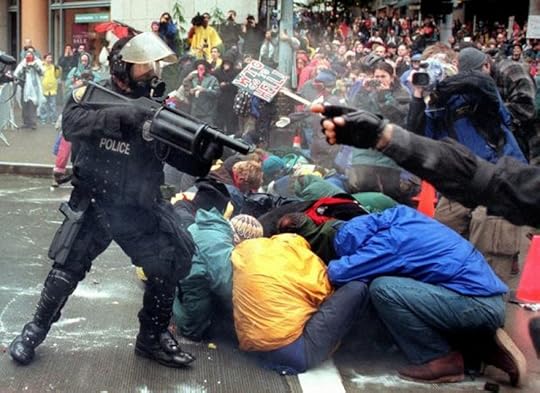
18
Battle in Seattle, USA
The largest demonstration in the US up to that point, 40,000 protesters surrounded the convention center.
(via)

19
Idle No More, Canada
An ongoing protest movement that arose in 2012 among the First Nations, Metis, and Inuit people of Canada as a reaction to treaty violations by the government, Idle No More also gained momentum as a global indigenous movement.
(via)

20
Prague Spring
In 1968, Communist leader Alexander Dubček led a movement in then-Czechoslovakia to remove Soviet authority; instead, the country split in two and the Soviet Union occupied them both for many years.
(via)
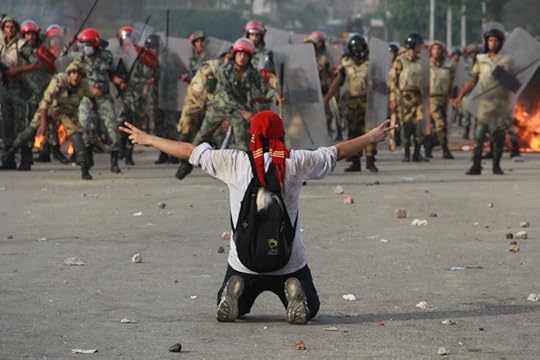
21
Abbasiya, Cairo, Egypt
As part of the ongoing Arab Spring, thousands or protesters marched into Abbasiya, a neighbourhood of Cairo. They were chased by police throwing rocks, and some were arrested and heavily beaten while being detained.
(via)

22
Euromaidan, Ukraine
Ukrainian protesters square off against riot police in a light snowstorm during the Euromaidan protests in early 2014.
(via)

23
Bogota, Colombia
A student protesting education reform tries to kiss a riot officer in Bogota in 2011.
(via)

24
Turkey
The Occupy Gezi protests spread across all of Turkey and caused heated fighting between police and protesters in the streets of the nation.
(via)
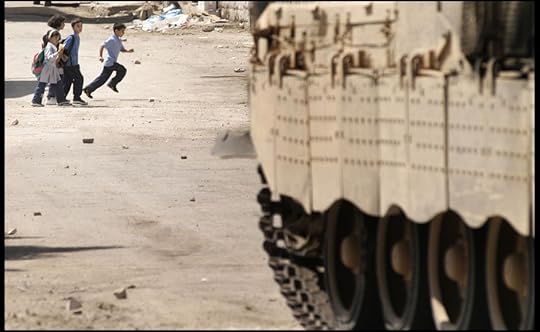
25
Palestine
The clashes between Palestinian militants and the occupying Israeli Army are heavily weighted in terms of firepower towards the much stronger and richer Israelis; these Palestinian children are running across the road to get to school.
(via)
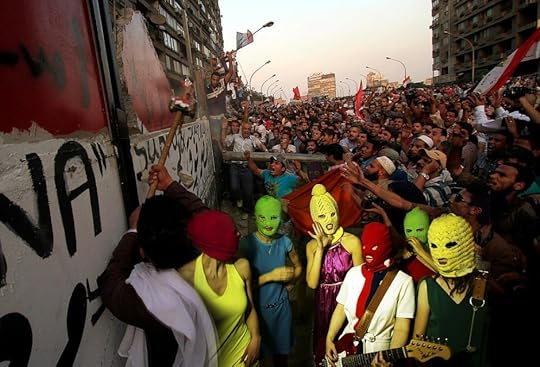
26
Pussy Riot, Russia
As part of the anonymous Russian punk protest group prone to guerilla tactics, two members of Pussy Riot were arrested and held without bail in 2012 for "hooliganism."
(via)

27
Million Hoodie March, USA
In 2012, an unarmed 17-year-old African-American boy named Trayvon Martin was coming back from a convenience store with some candy, while wearing a hoodie, and was shot and killed by a self-appointed neighbourhood watchman, George Zimmerman. Thousands rallied for justice.
(via)

28
Caracas, Venezuela
In early 2014, protests in Venezuela were sparked when a couple was killed during a carjacking while their five-year-old daughter looked on; soon, public demonstrations of thousands protested the lack of basic goods and an increase in political violence.
(via)

29
UN Rio+20, Brazil
In 2012, a Brazilian indigenous man protested a summit on sustainable development as his traditional land was handed over to extraction companies for mining.
(via)
The post 29 powerful images from protests worldwide appeared first on Matador Network.

March 16, 2014
Pigeons are a nuisance [vid]
This video of bird catchers in Spain really upsets me. The pigeons are tricked with food, sent into shock beneath a catapulted net, and later asphyxiated using carbon dioxide gas. I dislike pigeons just as much as any New Yorker, but I don’t think I could bring myself to hurt, or torture the poor birds.
Then it got me wondering — what are NYC’s pigeon-control methods? The results shocked me even more. In my hometown, some people go as far as to catch pigeons in cages or nets, and illegally transport them outside of the city to restaurants, or shooting ranges to be used for sport. So the dirty, nasty, poop-happy birds we despise so much, could actually end up on our dinner plates.
Nobody likes pigeons, but are they really so terrible that we must resort to hillbilly methods of extraction? [image error]
The post Is this really the best way to get rid of pigeons? appeared first on Matador Network.

March 15, 2014
You might be a 20th century slaver
I KNOW THAT slavery exists in this world — perhaps not in the same way that impacted American history, but still an unacceptable option in today’s global economy. But I never thought the things I buy, and the lifestyle I lead, contributed to this abuse of human rights. Most of us are none the wiser, and it doesn’t mean we’re bad people; but with more awareness, we can make better choices, and possibly impact the industries that take advantage of those who provide us with the luxuries we take for granted.
Check out this interactive, informative quiz produced by Made in a Free World, and see how many ‘slaves’ it takes to maintain your lifestyle. 
The post You might be a 20th century slave owner — take this quiz to find out appeared first on Matador Network.

Craziest airport announcement ever?
WE’VE ALL HEARD THE ANNOUNCEMENT at the airport: “Attention all passengers, do not leave your luggage unattended…” It’s easy to tune out, but it seems no matter what country you’re in, the announcement is always made by a woman with a soothing, calm voice.
Well, almost always…
As comedian Trevor Noah points out, they do things a little different in South Africa. And the result is friggin’ hilarious. 
The post South Africa has the craziest airport announcements ever [vid] appeared first on Matador Network.

March 14, 2014
Never date a girl who travels

Photo: Noukka Signe
SHE’S THE ONE WITH the messy unkempt hair colored by the sun. Her skin is now far from fair like it once was. Not even sun kissed. It’s burnt with multiple tan lines, wounds, and bites here and there. But for every flaw on her skin, she has an interesting story to tell.
Don’t date a girl who travels. She is hard to please. The usual dinner-movie date at the mall will suck the life out of her. Her soul craves new experiences and adventures. She will be unimpressed with your new car and your expensive watch. She would rather climb a rock or jump out of an airplane than hear you brag about it.
Don’t date a girl who travels because she will bug you to book a flight every time there’s an airline seat sale. She won’t party at Republiq. And she will never pay over $100 for Avicii because she knows that one weekend of clubbing is equivalent to one week somewhere far more exciting.
Chances are, she can’t hold a steady job. Or she’s probably daydreaming about quitting. She doesn’t want to keep working her ass off for someone else’s dream. She has her own and is working towards it. She is a freelancer. She makes money from designing, writing, photography, or something that requires creativity and imagination. Don’t waste her time complaining about your boring job.
Don’t date a girl who travels. She might have wasted her college degree and switched careers entirely. She is now a dive instructor or a yoga teacher. She’s not sure when the next paycheck is coming. But she doesn’t work like a robot all day, she goes out and takes what life has to offer and challenges you to do the same.
Don’t date a girl who travels, for she has chosen a life of uncertainty. She doesn’t have a plan or a permanent address. She goes with the flow and follows her heart. She dances to the beat of her own drum. She doesn’t wear a watch. Her days are ruled by the sun and the moon. When the waves are calling, life stops and she will be oblivious to everything else for a moment. But she has learned that the most important thing in life isn’t surfing.
Don’t date a girl who travels, as she tends to speak her mind. She will never try to impress your parents or friends. She knows respect, but isn’t afraid to hold a debate about global issues or social responsibility.
She will never need you. She knows how to pitch a tent and screw her own fins without your help. She cooks well and doesn’t need you to pay for her meals. She is too independent and won’t care whether you travel with her or not. She will forget to check in with you when she arrives at her destination. She’s busy living in the present. She talks to strangers. She will meet many interesting, like-minded people from around the world who share her passion and dreams. She will be bored with you.
So never date a girl who travels unless you can keep up with her. And if you unintentionally fall in love with one, don’t you dare keep her. Let her go. 
This post was originally published at Love the Search and is reprinted here with permission.
The post Why you should never date a girl who travels appeared first on Matador Network.

Celebrate Pi Day with Pizza Brain
I FIRST MET Joe Hunter when he worked at D’Allesandro’s pizza shop in Charleston, South Carolina. When I heard he had moved to Philadelphia to help open a pizza shop, I was sold — Joe’s pizzas are the bomb, and Philly is my favorite city in America. Pizza Brain is shaping the way people eat, produce business, and come together as a community.
To celebrate Pi Day, (March 14, 3.14…get it?), here are some images from my recent visit to Pizza Brain. If you’re in the Philly area, I recommend checking them out (the attached ice cream shop also serves pizza-flavored ice cream).
All photos by Tom Cappellino. 

1
Welcome to Pizza Brain
Pizza Brain opened on September 7, 2012, in the Kensington neighborhood of Philadelphia. It is decorated with items from owner and pizza enthusiast Brian Dwyer's collection of over 1,000 pizza memorabilia pieces.

2
Pizza Museum
The restaurant also doubles as a pizza "museum," and is the first of it's kind in the United States. Dwyer's unique collection earned him a Guinness World Record in 2011. About 30% of his collection is on display.

3
Delicious, delicious pizza
This ain't your normal slice of pizza, folks. Pizza Brain specializes in "gourmet 'za," combining locally-sourced ingredients to create eclectic pies, like the Esteban Destino, baked with roasted pork, cilantro, lime juice, jalapenos, and blackbeans, and the Bernie Templeton, which uses goat cheese, potatoes, fresh rosemary, scallions, and bacon -- sort of like a baked potato pizza, if you will.
Intermission
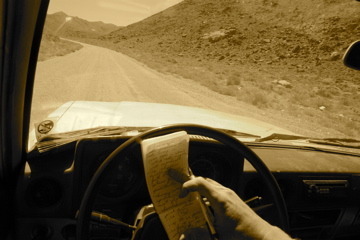
Writing and Driving: Notes from 1000 RPMs

In Search of the Real Dude: Notes from a Lebowski Fest Past
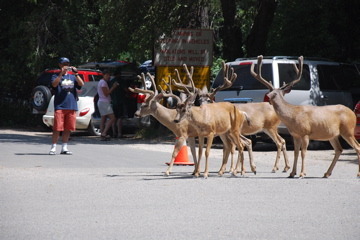
How to save America’s Parks: Pack ‘em with people?

4
Makin' 'za
Pizza making is no joke. Chef Joe Hunter showed me the entire process, from start to finish; kneading all that dough, and working with heavy machinery, has permanently changed the muscle mass in one of Joe's arms.

5
Touches of Philly
Pizza Brain has totally embraced its place in the land of cheesesteaks, and Rocky stairs. "It's such a historically weird, mysterious, and often-overlooked place," remarked Dwyer. "And one that's pigeon-holed a lot by outsiders. In our mind, that’s incredibly fertile ground for authentic creative expression to take place."

6
Pizza art
Pizza Brain's patio is decorated with Philly-centric art. Local artist James ‘Hawk’ Krall created the 40-foot "pizzalebrity" mural, and the ground-to-roof mosaic was put together by Isaiah Zagar, the man behind Philadelphia's Magic Gardens.

7
The brain behind Pizza Brain
Dwyer and Hunter have been friends since 2011, and both actively contribute to the running of the restaurant (on the day of this shoot, Dwyer was found behind the counter, chatting with customers and taking orders). "Pizza, and the culture attached to it, is a shared experience," said Dwyer. "I think Philly, and Pizza Brain, truly revels in that fact."
The post Celebrate Pi Day with a slice from Pizza Brain appeared first on Matador Network.

On the sticky ethics of voluntourism

Photo: Pippa Biddle
THE DEBATE ABOUT THE APPROPRIATENESS of voluntourism — how best to do it, where to do it, or whether it’s ethical to attempt at all — has been a very sensitive subject both with readers here at Matador and across the internet more broadly, judging from the literally millions of views and thousands of comments directed at Pippa Biddle’s recent piece on little white girls and boys volunteering in the developing world (which Matador republished earlier this week).
I caught up with Pippa to ask her more about the impact her story has had, and her thoughts on the ethics of the market for voluntourism.
* * *
RS: What has the feedback to your piece been from people who go on, or provide, voluntourism opportunities? Has it been self-reflective at all?
PB: The feedback on my post has been varied. I knew the topic, and the way that I addressed it, would be controversial. What I didn’t expect was how far the piece would spread. Moderating the 600+ comments on the post on my blog alone (not including comments on Medium, Thought Catalog, Huff Po Impact, etc.) was a learning experience.
I started off by reading each one but, very quickly, realized it would be better for my mental health and work schedule to just approve them. I believe in freedom of speech, so the only comments I have not approved were spam. This means that there can sometimes seem to be a lot of hate on my blog — I like to think of it as lively conversation.
Do you think it would’ve been possible for you to reach the same point of self-reflection on how best to help distant communities without your awkward first attempts at volunteering? Is unhelpfully trying to help others an inevitable step to getting it right?
I can’t remark on what would have been possible or impossible, as I’m not living two parallel lives. I do believe that a negative experience, even with an eventual positive outcome, is not justified by that outcome. I could have learned a similar lesson volunteering in my own community and it would have had much fewer costs.
Often, well-intentioned potential-voluntourists are aware of how problematic the practice can be, but are at a loss for a better, less ethically fraught way of making a difference. What would your advice to them be?
If you are looking for volunteer/advocacy work, look local. Organizations that support global causes through local initiatives, and that I respect, include She’s the First, Pencils of Promise, and Roots & Shoots.
I also believe that traveling for the sake of exploration and adventure is hugely important. It is imperative that young people are smart about where they travel, how they travel, and who they travel with. By embracing your role as a visitor you can, I have found, create a power dynamic weighted in favor of the locals.
What are your thoughts on voluntourism and voluntour operators as an industry? Do you think it’s problematic to have a market for companies to make money off providing a foreign stage for people to act out their good intentions?
I think that it is naive to think any company or nonprofit that sends young people to the developing world for “service” trips does not have to be researched thoroughly. Many of these programs spend upwards of 60% of income on advertising. That is crazy to me. They are (with some exceptions) programs that are in the business of generating profits.
Social enterprises are great, but sometimes we get so caught up in the glamour of the mission that we forget to do our due diligence on the program orchestrating it. It is up to each individual to take the time to do that research and make an informed decision on whether they should go themselves. 
The post On the sticky ethics of voluntourism appeared first on Matador Network.

Matador Network's Blog
- Matador Network's profile
- 6 followers




